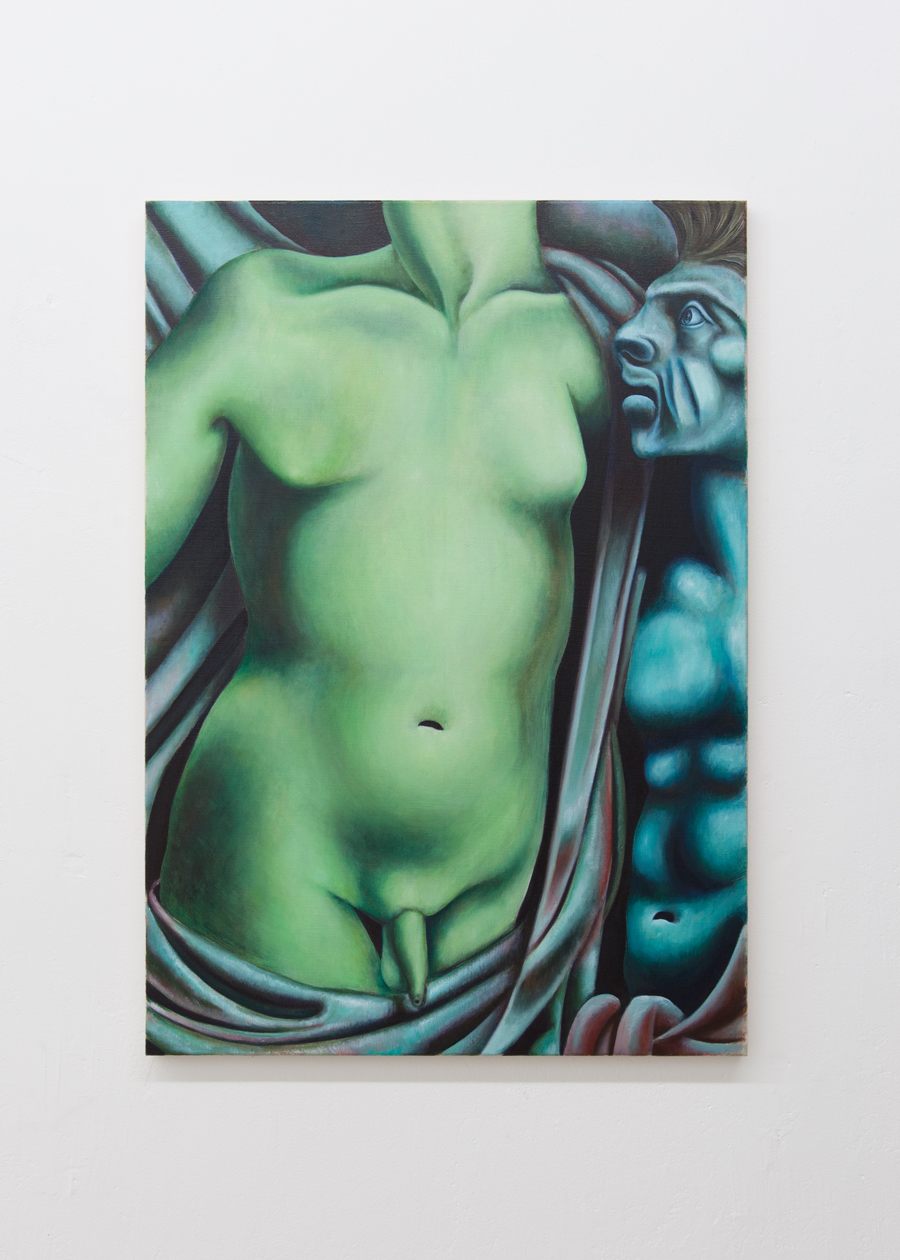Jannis Marwitz
Lucas Hirsch, Dusseldorf, Germany
Lucas Hirsch, Dusseldorf, Germany

In the original Doctor Who television series, humanoid aliens called Time Lords traverse the ages in lavish costumes reminiscent of those worn by Roman or Mayan demagogues. Stalwart fans of the show could well mistake the beings lingering in Jannis Marwitz’s solo exhibition, ‘Like Unhappy Fruit’, for these extraterrestrial time travellers, but most viewers will likely recognize the canvases as strange mimicries of baroque painting and relief. The oil and tempera works on display at Lucas Hirsch are populated by anthropomorphic deities, along with the requisite props: animals, jugs, chariots, flowing plants. All have a soft glow, courtesy of the artist's glazing techniques, which recall antique painting, and all set descending shadows and rising highlights swirling through hues of blue, green, gold, pink and purple. While a cryptic text links the show to the ancient Greek god Dionysos, Marwitz’s figures remain un-moored from narrative. Ergo, they initially seem like mute servants to the simple pleasure of painting. But these works are too loaded to sustain such a cheap conclusion – too expressive of the strained relationship between ancient memory and present-day flesh and blood.

Generally associated with late-twentieth-century mash-ups – neo-neo-neo-classical shopping malls; suburban mansions fronted by pillars and decorative lions – postmodernism has in fact been a recurrent artistic method throughout history. It follows that Marwitz’s pictures are but one recent pulse in a long echo of quotation and adaption. It’s their strange alien comportment, however, that sets the show apart from facile revivalism. In Untitled (all works 2017), two pink figures hold the large canvas’s centre. Piled golden hair, festooned with fruit and flowers, suggests that these are women, but hackneyed sexual codifications are resisted by their flatly muscled chests, and non-existent nipples. Likewise, in Comme des fruits malheureux (Like Unhappy Fruit, 2017), an emerald torso, boasting breast-like pectorals, stands above a flaccid, hairless penis. A teal character gazes at this smooth body, its face made from angular folds, its dark hair arced into a punkish mohawk.
A flowing, rose-coloured robe engulfs the aforementioned pink figures in Untitled, and around the lavish fabric, a host of smaller entities. As one grotesque peeks out of a dark hollow between the androgynes’ heads, the picture’s centrifugal composition is broken by characters who drift outside of the frame – a dog’s head has been cropped from the scene, leaving only its haunches and tail. Gazing at that dog’s backside, which lends the picture a disarming absurdity, I thought of the backwardness implicit in our over-esteeming of European cultural history; how this history often seems to be an agglomeration of myths cobbled together by the keepers of a dominant, white, European patrimony. Who needs the dog’s thinking head, the painting seems to ask, when its ass-end is such a perfectly mute accoutrement? Marwitz’s pictures pursue the baroque mode with such unflinching commitment that these critiques are filtered through a deeply idiosyncratic subject position: a faith in antique visual languages and a pleasure taken in old painting processes. A conflict thus burns slowly in this show, between a problematic European heritage and the artist’s own ambivalent attitude.

One single exception to the show’s stylistic theme bolsters its self-reflexivity, without forcing the issue: Fruit (2017), in which a white naturalistic face gazes over the viewer’s right shoulder, as if the artist is picturing himself picturing the surrounding interpretations of classicism. In a past life, I would have described this subject as a man; now, thankfully, such designations seem less adequate with every passing day. Where the pinkish visage gives way to grey-shadowed crevices, flecks of turquoise echo both the picture’s background and the subject’s eyes. This fleshy countenance is all the more palpable for being ever so slightly cartoonish. So, too, is the troubled relationship of inheritance between the staring figure and its alien history.
Main image: Installation view, Jannis Marwitz, 'Like unhappy fruit', 2017, installation view, Lucas Hirsch, Dusseldorf, Germany. Courtesy: Lucas Hirsch, Dusseldorf
























